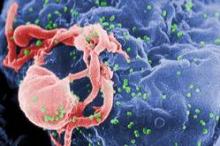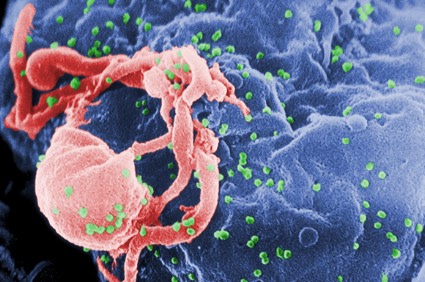User login
Even as antiretroviral therapies began making inroads into the AIDS epidemic, the virulence of HIV-1 increased and the time from seroconversion to a significant CD4-cell drop was cut in half, investigators reported at the Conference on Retroviruses and Opportunistic Infections.
"These results have important public health implications, as higher viremial levels are associated with higher risk of transmission. Based on published formulas, our estimated increase of 0.4 log10 copies/mL in viral set point corresponds to a potential 44% increase in transmissibility," reported Dr. Giota Touloumi, of Athens University, in a briefing.
"We all know that the HIV-1 is characterized by huge genetic diversity, and different strains of the virus may differ in virulence," said coinvestigator and lead author Dr. Nikos Pantazis, also from Athens University. Dr. Pantazis presented the data in a plenary session.
In the era before antiretroviral therapy (ART), HIV virulence was measured directly by time to the development of AIDS and death. In the ART era, however, clinicians must rely on marker-based proxies of virulence, such as CD4 seroconversion, CD4 slope (i.e., rate of decline), and viral load set point.
"The picture we have from published research is mixed, with conflicting results, and [some] studies suggest that the HIV virulence has increased, others declare it stable, and others say the virulence is even decreasing," he said.
To see whether the virulence of HIV-1 has changed over the course of the epidemic, the investigators reviewed data from CASCADE, a collaboration between the investigators of 26 cohorts of persons with well-estimated dates of HIV seroconversion. They did not include data on African cohorts, patients with seroconversion from 2009 on, or children.
They censored follow-up either at the time of ART initiation or at the onset of clinical AIDS. A total of 15,875 cohort members met the study criteria.
The authors estimated the CD4 counts at seroconversion declined from about 770/mcL in the early 1980s to about 570/mcL after 2000. The virulence appeared to plateau after the turn of the millennium, they noted.
The rate of CD4-cell loss (CD4 slope) was relatively stable up to 1996, but accelerated from 1996 through 2004. In addition, the estimated HIV set point (viral load) increased from 4.05 log10 copies/mL in 1980 to 4.50 in 2002, suggesting a more virulent virus.
The results are compatible with both a 2012 meta-analysis (AIDS 2012;26:193-205 [doi: 10.1097/QAD.0b013e32834db418]) and a 2007 evolutionary hypothesis (Proc. Natl. Acad. Sci. USA 2007;104:17441-6), Dr. Pantazis said.
The combined findings of a drop in CD4 cell count of about 200 cells/mcL over 30 years and an apparent increase in CD4 slope translated into an estimated 50% decrease in the time from seroconversion to 350 CD4 cells/mcL, from 7 years in a 1980 seroconverter to 3.4 years in a 2004 seroconverter, he said.
Although the study was subject to residual confounding bias, such as changes in methods for viral load and CD4 cell count assays and quantification, and difficulties in pinpointing the time of seroconversion, a wide range of sensitivity analyses furnished qualitatively similar results, Dr. Pantazis said.
The study was supported by a grant from the European Union. Dr. Pantazis, Dr. Touloumi, and their colleagues reported having no financial disclosures.
Even as antiretroviral therapies began making inroads into the AIDS epidemic, the virulence of HIV-1 increased and the time from seroconversion to a significant CD4-cell drop was cut in half, investigators reported at the Conference on Retroviruses and Opportunistic Infections.
"These results have important public health implications, as higher viremial levels are associated with higher risk of transmission. Based on published formulas, our estimated increase of 0.4 log10 copies/mL in viral set point corresponds to a potential 44% increase in transmissibility," reported Dr. Giota Touloumi, of Athens University, in a briefing.
"We all know that the HIV-1 is characterized by huge genetic diversity, and different strains of the virus may differ in virulence," said coinvestigator and lead author Dr. Nikos Pantazis, also from Athens University. Dr. Pantazis presented the data in a plenary session.
In the era before antiretroviral therapy (ART), HIV virulence was measured directly by time to the development of AIDS and death. In the ART era, however, clinicians must rely on marker-based proxies of virulence, such as CD4 seroconversion, CD4 slope (i.e., rate of decline), and viral load set point.
"The picture we have from published research is mixed, with conflicting results, and [some] studies suggest that the HIV virulence has increased, others declare it stable, and others say the virulence is even decreasing," he said.
To see whether the virulence of HIV-1 has changed over the course of the epidemic, the investigators reviewed data from CASCADE, a collaboration between the investigators of 26 cohorts of persons with well-estimated dates of HIV seroconversion. They did not include data on African cohorts, patients with seroconversion from 2009 on, or children.
They censored follow-up either at the time of ART initiation or at the onset of clinical AIDS. A total of 15,875 cohort members met the study criteria.
The authors estimated the CD4 counts at seroconversion declined from about 770/mcL in the early 1980s to about 570/mcL after 2000. The virulence appeared to plateau after the turn of the millennium, they noted.
The rate of CD4-cell loss (CD4 slope) was relatively stable up to 1996, but accelerated from 1996 through 2004. In addition, the estimated HIV set point (viral load) increased from 4.05 log10 copies/mL in 1980 to 4.50 in 2002, suggesting a more virulent virus.
The results are compatible with both a 2012 meta-analysis (AIDS 2012;26:193-205 [doi: 10.1097/QAD.0b013e32834db418]) and a 2007 evolutionary hypothesis (Proc. Natl. Acad. Sci. USA 2007;104:17441-6), Dr. Pantazis said.
The combined findings of a drop in CD4 cell count of about 200 cells/mcL over 30 years and an apparent increase in CD4 slope translated into an estimated 50% decrease in the time from seroconversion to 350 CD4 cells/mcL, from 7 years in a 1980 seroconverter to 3.4 years in a 2004 seroconverter, he said.
Although the study was subject to residual confounding bias, such as changes in methods for viral load and CD4 cell count assays and quantification, and difficulties in pinpointing the time of seroconversion, a wide range of sensitivity analyses furnished qualitatively similar results, Dr. Pantazis said.
The study was supported by a grant from the European Union. Dr. Pantazis, Dr. Touloumi, and their colleagues reported having no financial disclosures.
Even as antiretroviral therapies began making inroads into the AIDS epidemic, the virulence of HIV-1 increased and the time from seroconversion to a significant CD4-cell drop was cut in half, investigators reported at the Conference on Retroviruses and Opportunistic Infections.
"These results have important public health implications, as higher viremial levels are associated with higher risk of transmission. Based on published formulas, our estimated increase of 0.4 log10 copies/mL in viral set point corresponds to a potential 44% increase in transmissibility," reported Dr. Giota Touloumi, of Athens University, in a briefing.
"We all know that the HIV-1 is characterized by huge genetic diversity, and different strains of the virus may differ in virulence," said coinvestigator and lead author Dr. Nikos Pantazis, also from Athens University. Dr. Pantazis presented the data in a plenary session.
In the era before antiretroviral therapy (ART), HIV virulence was measured directly by time to the development of AIDS and death. In the ART era, however, clinicians must rely on marker-based proxies of virulence, such as CD4 seroconversion, CD4 slope (i.e., rate of decline), and viral load set point.
"The picture we have from published research is mixed, with conflicting results, and [some] studies suggest that the HIV virulence has increased, others declare it stable, and others say the virulence is even decreasing," he said.
To see whether the virulence of HIV-1 has changed over the course of the epidemic, the investigators reviewed data from CASCADE, a collaboration between the investigators of 26 cohorts of persons with well-estimated dates of HIV seroconversion. They did not include data on African cohorts, patients with seroconversion from 2009 on, or children.
They censored follow-up either at the time of ART initiation or at the onset of clinical AIDS. A total of 15,875 cohort members met the study criteria.
The authors estimated the CD4 counts at seroconversion declined from about 770/mcL in the early 1980s to about 570/mcL after 2000. The virulence appeared to plateau after the turn of the millennium, they noted.
The rate of CD4-cell loss (CD4 slope) was relatively stable up to 1996, but accelerated from 1996 through 2004. In addition, the estimated HIV set point (viral load) increased from 4.05 log10 copies/mL in 1980 to 4.50 in 2002, suggesting a more virulent virus.
The results are compatible with both a 2012 meta-analysis (AIDS 2012;26:193-205 [doi: 10.1097/QAD.0b013e32834db418]) and a 2007 evolutionary hypothesis (Proc. Natl. Acad. Sci. USA 2007;104:17441-6), Dr. Pantazis said.
The combined findings of a drop in CD4 cell count of about 200 cells/mcL over 30 years and an apparent increase in CD4 slope translated into an estimated 50% decrease in the time from seroconversion to 350 CD4 cells/mcL, from 7 years in a 1980 seroconverter to 3.4 years in a 2004 seroconverter, he said.
Although the study was subject to residual confounding bias, such as changes in methods for viral load and CD4 cell count assays and quantification, and difficulties in pinpointing the time of seroconversion, a wide range of sensitivity analyses furnished qualitatively similar results, Dr. Pantazis said.
The study was supported by a grant from the European Union. Dr. Pantazis, Dr. Touloumi, and their colleagues reported having no financial disclosures.
FROM CROI 2014
Major finding: An increase in the HIV-1 viral set point from 1980 through 2000 translates into an estimated 44% increase in viral transmissibility.
Data source: Retrospective study of 15,875 HIV-positive patients in 1 of 26 cohorts.
Disclosures: The study was supported by a grant from the European Union. Dr. Pantazis, Dr. Touloumi, and their colleagues reported having no financial disclosures.

